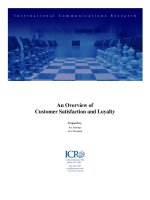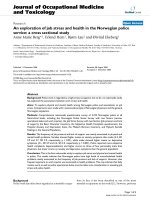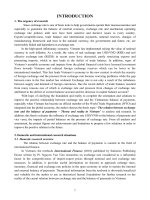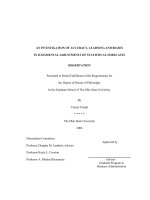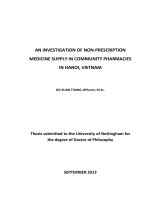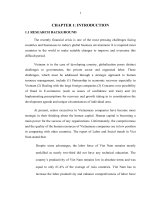An investigation of customer value and patronage in retailing vending machine sector in vietnam
Bạn đang xem bản rút gọn của tài liệu. Xem và tải ngay bản đầy đủ của tài liệu tại đây (1.23 MB, 75 trang )
UNIVERSITY OF ECONOMICS HO CHI MINH CITY
International School of Business
NGO TRONG TRUNG
AN INVESTIGATION OF CUSTOMER VALUE AND
PATRONAGE IN RETAILING VENDING MACHINE
SECTOR IN VIETNAM
MASTER OF BUSINESS (Honours)
Ho Chi Minh City – Year 2014
UNIVERSITY OF ECONOMICS HO CHI MINH CITY
International School of Business
NGO TRONG TRUNG
AN INVESTIGATION OF CUSTOMER VALUE AND
PATRONAGE IN RETAILING VENDING MACHINE
SECTOR IN VIETNAM
ID: 22120143
MASTER OF BUSINESS (Honours)
SUPERVISOR: LE NHAT HANH, PhD
Ho Chi Minh City – Year 2014
i
ACKNOWLEDGEMENT
I would like to thank my supervisor, Dr. Hanh Nguyen for her encouragement and
guidance throughout the process of conducting this thesis. I would also like to thank other
members of my advisor committee, Dr. Tho Nguyen, Dr. Nguyen, Dr. Quan, Dr. Phong, and
Dr. Thao for helping me to understand the process and theoretical foundations of the
research.
Many others also deserve my gratitude. Among them, Mr. Doanh, Mr. Tuan, Ms.
Kim Yen, Master Mai Thien Tam, Ms. Nguyet Anh, Mr. Huy, Master Nguyen Thi Nguyet
and Master Nguyen Huy Khai, helped me to obtain final questionnaire being suitable in the
context of Vietnam. My colleagues, friends and all of respondents supported to conduct the
questionnaire at the best reliability.
Finally, I would like to express my gratitude to my family for their love and support,
and they are always there when I need them. Without their emotional and financial support,
this study would not be completed.
ii
ABSTRACT
Although Vending machine was predicted would become one of the most important
non-store marketing channels, many retailers using vending machine have a difficult time in
developing business in Vietnam. If vending machine-retailers want to attract more and more
shoppers, they need to know what evaluative criteria consumers use when selecting a
vending machine-retailer. The past researches demonstrated that Customer value and Retail
patronage could enhance retail performance. This study investigated the relationship
between Customer value and Retailing vending machine patronage, and examines the
relationships of antecedents including Customization, Functionality and Perceived Risk with
Customer Value. By utilizing literature review, a research model was proposed to identify
the relationships above. Additionally, a convenient sample of 247 respondents in Ho Chi
Minh City was surveyed to test the theoretical model. Structure Equation Modeling (SEM)
was used to analyzed the data. The final result indicated that Customization and
Functionality are positively related to Customer value, but perceived risk was not supported.
Customer value is positively related to retailing vending machine patronage.
iii
TABLE OF CONTENTS
ACKNOWLEDGEMENT i
ABSTRACT ii
TABLE OF CONTENTS iii
LIST OF TABLES v
LIST OF FIGURES vi
CHAPTER 1: INTRODUCTION 1
1.1 Research background 1
1.2 Research Problem 2
1.3 Research Objective 3
1.4 Significance of the Study 3
1.5 Research methodology and scope 3
1.6 The structure of the study 4
CHAPTER 2: LITERATURE REVIEW AND HYPOTHESES 6
2.1 Vending machine 6
2.2 Customer value 7
2.3 Customization and Functionality 8
2.4 Perceived risk 9
2.5 Customer value and retail patronage 10
2.6 Research model 11
CHAPTER 3: METHODOLOGY 13
3.1 Research process 13
3.1.1 Qualitative research 13
3.1.2 Quantitative research 13
3.2 Research design 17
3.3 Measurements of constructs 18
3.4 Data analysis method 21
3.4.1 Descriptive Statistics 21
3.4.1.1 Test of Skewness 22
3.4.1.2 Test of Kurtosis 22
3.4.2 Confirmatory factors Analysis (CFA) 22
3.4.2.1 Reliability testing 22
3.4.2.2 Convergent validity 22
iv
3.4.2.3 Discriminant validity 23
3.4.3 Structure Equation Modeling (SEM) 23
3.4.4 Bootstrap 23
CHAPTER 4: DATA ANALYSIS AND RESULTS 25
4.1 Sample characteristic 25
4.2 Descriptive statistics 26
4.3 Confirmatory Factor Analysis (CFA) 28
4.4 Structural Equation Modeling (SEM) 38
4.5 Bootstrap analysis 40
4.6 Explanation for finding result of hypotheses 41
CHAPTER 5: CONCLUSION, IMPLICATIONS AND LIMITATION 46
5.1 Conclusion 46
5.2 Implications 47
5.3 Limitation 48
REFERENCES 50
APPENDIX 58
v
LIST OF TABLES
Table 3.1: The result of collected data 15
Table 3.2: Measurement scales 19
Table 4.1: Sample Characteristic 26
Table 4.2: The result of Skewness and Kurtosis testing 27
Table 4.3: Correlations of components 32
Table 4.4: The result of correlation test 32
Table 4.5: Summary of measurement validation 34
Table 4.6: Correlation of Constructs 36
Table 4.7: Chi-square difference test 37
Table 4.8: Hypotheses Unstandardized Structural Paths 40
Table 4.9: Summary of hypotheses testing result 40
Table 4.10: The result of bootstrap analysis 41
vi
LIST OF FIGURES
Figure 1: Conceptual Model 12
Figure 3: CFA of first-order constructs 29
Figure 4: CFA of second-order construct 31
Figure 5: CFA final 33
Figure 6: Customer value versus retailing vending machine patronage 37
Figure 7: SEM model 39
Figure 8: Structural results (Standardized estimates) 44
1
CHAPTER 1: INTRODUCTION
1.1 Research background
More than three decades ago, Quelch and Takeuchi (1981) predicted that vending
machine would become one of the most important non-store marketing channels. Reality,
their prediction has surely materialized. Most of countries all over the world used vending
machine as retail business. There are more than seven millions vending machines in
operation in U.S (Leaner 2002), Japan has become a vending-machine-country and Vietnam
also has the first vending machines in 2000s.
Vending machine offers consumer a variety of products including food, snack,
beverages, newspaper, cosmetic, CDs, cigarettes and so on. Lee (2013) argued that as more
people has joined workforce during the past several decades and their busy social life
increasingly places more value on time and convenience, vending machine had become an
indispensable part of many people daily’s lives.
In Vietnam, vending machine was deployed in early 2000s when the Vietnam’s
Government issued the coins and experts believe that they will be potential market in the
future (Kieu Giang, 2004). However, vending machine sector developed slowly during past
time. There were many investors failed in applying Vending machine for retail business.
The first main reason can explain for this is technology. Most of vending machine at that
time integrated used-coin technology, but Vietnam people do not have habit keeping the
coin available or do not like to use coin in transaction. This leads used-coin vending
machine to be inconvenient for customer to reach and purchase by vending machine;
secondly, retailers using vending machines cannot find the suitable locations to install
vending machine, especially two biggest cities in Vietnam: Ho Chi Minh City and Hanoi
City for sidewalk and public areas are quite narrow. As a result, vending machine cannot
operate at the best; finally, most of the companies invested vending machine sector at that
time, were small and not enough ability to invest new modern vending machines, while the
companies having enough potential did not want to joint into this industry to push the
vending machine sector in Vietnam (Hong Phuc, 2005).
2
Fortunately, the business environment has changed in recent years leading to many
good signs from vending machine sector. First of all, technology is improved, current
vending machine can accept both the cash and coin, even consumer can use credit card to
purchase some product sold by vending machine. This makes vending machine to be more
convenient for customer. On the other hand, some big brand names in Vietnam: Pepsi, Coca
Cola, begin to use vending machine to sell their product at public areas such as hospital,
park, railway station, bus station and airport. All above things have prompted vending
machine sector grow quicker and quicker.
Based on those, author will conduct a study to investigate about relevant knowledge
of vending machine sector in Vietnam.
1.2 Research Problem
Given the ever increasing presence and the pervasiveness of vending machines in
lives of consumers, it is surprising that there have been to date no studies in marketing and
consumer behavior literature that shed light on consumers’ usage behavior with vending
machines services in Vietnam. Furthermore, most research has focused on purchase
intention, which is customer acquisition oriented, little research has examined consumers’
patronage behavior, which is customer retention oriented. However, customer retention is
more important than customer acquisition, and building customer value is the key to
retaining customers (Weinstein, 2002).
On the other hand, Customer value has emerged as a crucial instrument for analyzing
service quality, customer satisfaction, and consumer behavior (Yieh, Chen, and Wei, 2012).
It is not only the antecedent of attitude, intention, and behavior (Gounaris et al. 2007;
Parasuraman and Grewal 2000; Yang and Peterson 2004) but also a critical factor
influencing customer retention and purchase intention (Chang and Wildt, 1994). In addition,
customer value is a strategic weapon in attracting and retaining customers and has become
one of the most significant factors in the success in service providers (Gale 1994;
Parasuraman 1997). Therefore, many previous studies examine relationship between
Customer value and consumer’s purchasing intention or satisfaction, but little of studies
research about influence of Customer value on Patronage behavior.
3
Thus, in order to fulfill this gap, an investigation of Customer Value and Patronage
behavior in retailing vending machine sector is examined, and in an effort to indentify the
key factors impacting on customer value in vending machine sector in Vietnam, this study
considers the concepts of Functionality, Customization, and Perceived Risk as antecedents
of Customer value.
1.3 Research Objective
To examine customer value in vending machine situation, it is necessary to focus on
identifying key factors affected customer value in using vending machine. These factors are
perceived risk, functionality and customization. Each of these can either positively or
negatively influence customer value in vending machine sector. Knowledge about the effect
of customer value on consumers’ vending machine patronage behavior provides helpful
implications to marketers in executing marketing and business strategy and customer
relationship management. Therefore, the overall purpose of this current study is to examine
how customer value affects consumers’ retailing vending machine patronage in Vietnam.
Particularly, this study investigates:
1. The impact of Customization of vending machine on Customer Value
2. The impact of Functionality of vending machine on Customer Value
3. The impact of Perceived Risk of using vending machine on Customer Value
4. The impact of Customer value on retailing vending machine patronage
1.4 Significance of the Study
The study will provide helpful implications for marketers in executing marketing and
business strategy in Vending machine sector in particular and in retail business in general.
1.5 Research methodology and scope
The research conducted on consumer in Ho Chi Minh City is one of the biggest cities
in Vietnam, where it centralizes all trading activities, people can reach new technologies in
business activities soonest, and the author can collect data from people from different
provinces and social levels in our country.
The main purpose of this research is perceived customer value of consumer in using
vending machine. Therefore, it’s necessary to only focus on the respondents had used the
4
vending machine for purchasing prior. There are three kinds of vending machine which
respondents can use in Ho Chi Minh are Vending massage chair, vending soft drink
machine, and vending exchange coin machine. Thus, only respondents had used one of
threes kinds of vending machine mentioned above, are chosen to conduct the questionnaires
for main survey.
The Author applies data analysis tool including Microsoft Excel and SPSS, to handle
the collected data and to conduct the research. The Author also uses Amos 22 software to
run Confirmation Factor Analysis (CFA) and Structural Equation Modeling (SEM), and to
check relationships between exogenous variables and endogenous variables in the proposed
research model.
1.6 The structure of the study
This paper is structured into five chapters. Specifically, the contents of each chapter
will be presented as follow:
Chapter 1: Introduction
In this part, research background, research problem, research objective, significant of
study, research scope and methodology, and structure of study will be presented
subsequently.
Chapter 2: Literature review and Hypotheses
In this chapter, the definitions of each concept and an extensive literature review will
be presented. Then hypotheses are also developed throughout the previous literatures and
finally, the research model will be proposed.
Chapter 3: Research Methodology
This chapter mentions about the research design, measurement of constructs,
illustrate the process of conducting the research, and then, data analysis method is also
presented to lay the foundation of chapter 4.
Chapter 4: Data Analysis and Result
This chapter includes Sample characteristic, descriptive statistic, CFA, SEM and
discussion of result.
Chapter 5: Conclusion
5
This chapter includes conclusion, Implications and limitation.
6
CHAPTER 2: LITERATURE REVIEW AND HYPOTHESES
In this chapter, author presented an extensive literature review, proposed hypothesis
and research model. An literature review focused on knowledge of vending machine, theory
related to customer value, retail patronage and relationship of constructs be mentioned by
others researches. Then, hypotheses were also argued and developed particularly by
previous studies to build a research model in this chapter.
2.1 Vending machine
According to Meuter et al (2000), Self-service Technology (SST) was the innovative
channel of marketplace transactions that was completely different from traditional channel.
Particularly, interpersonal contact was not required between customer and service providers,
customer have to perform entire service by themselves without direct support of employees
(Bitner et al., 2002). The types of SSTs deployed by service providers include self-service
gas stations, launderettes, and vending machines (Bateson, 1985);self- health diagnosis,
ATMs, Online Banking and buffet restaurant (Meuter et al., 2000); and in this study, author
only focus on one of types of SSTs is vending machine.
Vending machine is a machine which dispenses items such as snacks, beverages,
alcohol, cigarettes, consumer products, after the customer insert the currency or credit card
into the machine. For marketers, vending machine supported to increase the reach and
intensity of their retail distributor network. They usually were placed outdoors and in
unattended environments such as large retail stores, hospital, gasoline station, offices,
railway station, airport, shopping malls (Lee, 2003). For customer, vending machines
offered the convenience, time saving benefit and 24-hours availability and reasonably fresh
and ready to serve products (Quelch and Tekeuchi, 1981).
As mentioned above, Vending machine was one of types of SSTs; it therefore
inherited adequately SSTs’ characteristics in the past researches. For instance, a self-service
model predicting customer acceptance of SST was proposed by Globerson and Maggard
(1991) that based on seven factors: convenience, time saving, self-control, money saved,
self-image, perceived risk and self-fulfillment; Meuter et al (2000) also proposed ease of
use, the ability to avoid interference from service people, time saving, convenience, and
7
financial saving as the factors impacting the adoption of SST, and ease of use was the most
important factor; service quality of SSTs included seven dimensions: Functionality,
Convenience, Enjoyment, Privacy, Assurance, Design, and Customization, in where,
Functionality represents responsiveness, reliability and ease of use of SSTs, and
Customization referred to extent of an SST can be altered to meet individual customer
preferences and transaction histories (Lin and Hsieh, 2011). On the other hand, Ho and Ko
(2008) proved that SST characteristics have positive effect on Customer Value. Therefore,
based on the literature regarding to Vending machine, the current study examines perceived
risk, functionality and customization to determine customer value of vending machine
sector.
2.2 Customer value
The concept of value has been applied in various fields of study, such as economics,
social science, accounting, finance, strategy, product management, information system, and
marketing (Huber et al., 2001; Ulaga and Chacour, 2001). Customers acknowledged service
value through desired purpose or goal achieved (Overby, 2005). Thus, in-depth
understanding of customer value construct was highly important.
The concept of customer value was often perceived as an ambiguous and
multifaceted word (Parasuraman, 1997). Many authors had acknowledged the difficulties
involved in defining customer value (e.g. Piercy and Morgan, 1997; Woodruff, 1997).
Therefore, many definition of customer value were proposed by many authors. For instance,
Holbrook (1994) defined customer value as “an interactive relativistic preference
experience” (p.5), and Woodruff (1997) expanded the concept of customer value as “a
customer’s perceived preference for and evaluation of those product attributes, attribute
performance, and consequences arising from use that facilitate (or block) achieving the
customer’s goal and purposes in use situation”(p.142). Customer value was also defined by
Chen and Dubinsky (2003) as “a consumer’s perception of the net benefits gained in
exchange for the cost incurred in obtaining the desired benefits” (p.326). However, there
was a general agreement in the literature that customer value was determined by
“customers’ perception not by suppliers” assumptions or intentions (Anderson and Narus,
8
1998; Woodruff and Gardial, 1996; Zeithaml, 1988); as Doyle (1989, p.83) put it: value is
“not what the producer puts in, but what the customers get out”. Based on those, in this
study, author used the common definition of customer value proposed by Hanny and Felix
(2009), is as “tradeoff between total perceived benefit and total perceived scarify” (p.480).
Sheth et al (1991) argued that customer value was determined by five factors:
functional value, epistemic value, social value, emotional value and conditional value.
Functional performance, economic utility, and benefit associated with possessing the service
express functional value. It is a concept of economic benefits of the trade-off between
quality and price and is presumed to be the primary driver of customer choice (Sheth et al.,
1991; Sweeney and Soutal, 2001). Customer’s feelings, for instance, love or hate,
comfortable or uncomfortable, happy or sad, etc when they experienced an organization’s
product or service represent emotional value. Epistemic value is the capacity of services or
products to provide novelty or curiosity and satisfy a desire for knowledge (Sheth et al.,
1991). Social value is limited to specific social groups (e.g., cultural-ethnic groups). Finally,
conditional value relate to special cases, such as an illness or some specific social situation
(Sheth et al., 1991; Sweeney and Soutal, 2001).
2.3 Customization and Functionality
The term of customization was defined as “Tailoring the product to the special and
unique needs of the customer. Each buyer is potentially a unique segment" (Bennett, 1988,
p. 51) or "to build, fit, or alter according to individual specifications" (p. 281) by Webster
(1973). Customization was one of the important factors which marketers paid more
attention to satisfy their each of specific customer segments. Terptra (1981) first brought the
idea of product customization to the academician’s attention. He also stated that “the idea of
product "appropriateness" was a legitimate one” (p.54). There were many different cultures
and traditions all over the world. Each of them had different style of behavior and style
leading to each of people’s demand in different cultures was completely different. By this,
understanding clearly specific customer’s demand was the key supported marketers to
design product or service meeting well for their own customer’s demand.
9
In marketing context, the functionality was defined as “what product does for the
buyers and users; utility it offers the user; what he or she can do with it” (Yellow pencil,
2006). Functionality referred to the ability of product or service to facilitate performance
and the accomplishment of service customer goal. It also was considered to be particular
importance because physical settings of vending machine were purposeful environment that
exists to fulfill specific needs of customers.
On the other hand, functionality and customization are two of dimensions of service
quality construct (Lin & Hsieh, 2011). Service, by providing additional value for customers,
leads to increased customer satisfaction, though the relationship between service and
satisfaction can be non-linear (Anderson and Mittal, 2000). In addition, service quality is
thought to lead to increases in firm profitability and market value through the service–profit
chain (Heskett et al. 1994). That’s the main reason why service quality has long been
recognized as a key factor for creating customer value. Based on literatures above, the
following hypotheses were proposed:
H1. Customization of vending machine is positively related to customer value
H2. Functionality of vending machine is positively related to customer value
2.4 Perceived risk
Risk was defined as term of uncertainly and consequences associated with
consumer’s action (Bauer, 1960). Base on this, many studies had adopted this definition to
define the construct of perceived risk, such as Cunningham (1967) argued that “perceived
risk as a consumer’s perception of the uncertainty and adverse consequences associated with
buying a product or service” (p. 91) or Dowling and Staelin (1994) understood that
“perceived risk is determined by the distinction between inherent risk and handle risk”
(p.121). In general, perceived risk referred that consumer purchase behavior may cause
some unexpected results and these results may cause unpleasant experience (Bauer, 1960).
Imaging that, customers always had their purchase goal each time when they wanted to buy
something (product or service). However, in some cases, customers did not know which
purchase decision was the best choice could meet their goal at the best. As a result, it would
cause unfavorable results and shape a risk consciousness (Cox, 1967).
10
Perceived risk was a multi-dimension construct including losses and risk factors,
which together, explain overall risk related to purchase or use a product or service. The
identified dimensions were financial, function, psychological, social, time, and physical
(Roselius, 1971). In this study, four dimensions chosen to explain the risk in using vending
machine were psychological, social, privacy, and time wasting.
Perceived risk was one of the factors to influence customer value. Sweeny, Soutar,
and Johnson (1999) said that customer value mean a tradeoff between benefits and sacrifices
of product or service from consumer’s point of view. Therefore, customer value was
affected by sacrifices and sacrifices equal to perceived risk. On the other hand, many studies
proved that perceived risk could reduce the customer value (Agarwal and Teas, 2001; Chen
and Dubinsky, 2003). Based on that, the present study proposed the following hypothesis:
H3: Perceived risk of vending machine users is negatively related to customer value.
2.5 Customer value and retail patronage
Retail patronage behavior was studied in many empirical researches (Lee, H.Y.,
Fairhurst, A.E., & Lee, M.Y., 2009). Lee et al, (2009) also argued that retail patronage
behavior can explain the mechanism of store choice. As a result, it has been a critical issue
for academicians and retail managers. However, because of the dynamic nature of patronage
behavior, a comprehensive picture of retail patronage behavior is a complicated model.
Laaksomen (1993) defines patronage as “all the possible inner features of dynamism around
the shopping behavior phenomenon in terms of store choice” (p.9). Thus, retail patronage
was focused on the identification of relevant attributes by one key research stream. Firstly,
according to Hartley (1980), understanding consumer’s patronage motives can reinforce the
basic determinants for consumer buying behavior. Hartley (1980) also defined patronage
motives as the reasons why customers choose in many different stores and proposed that
“customer considered about patronage factors which indicated the reasons why they shop
stores. The patronage factors consist of: Convenience _ Location, hour working, shopping
ease; Assortment of merchandise _ Variety or limited; Quality and fashion level of goods _
High quality and fashion; Prices _ Lower price; Service _ Credit Card, delivery, return-
goods, and knowledgeable sales staff; Excitement _ promotional effort, use of celebrities
11
and fashion show” (p.77). Secondly, Morgenstein and Strongin (1992) stated that patronage
motives as “the reasons why customer choose one place to shop rather than other and
include special brand, attractive facilities, personal service, conveniences, goods value,
attentive salespeople, and a good store image” (p. 124). Finally, Pan and Zinkhan (2006)
categorized a large number of determinants of retail patronage that were frequently
examined in prior studies into three factors: product-relevant factors, market-relevant
factors, and personal factors. Product-relevant factors is related to function of product and
attributes (product quality, assortment, and price); market-relevant factors pertained to
service offered by store with respect to convenience, service quality, store image and
atmosphere, and salespeople; and personal factors refer to consumer characteristic (e.g . age,
gender, income, and so on).
According to Lee et al (2009), three groups of determinants including product
quality, service quality, and assortment had the strongest influence to consumers’ decision
to patronize a particular store. This finding presented clearly the importance of service
quality as a key to achieve retail patronage. Furthermore, Yieh & Wei (2012) also stated that
customer value was a crucial instrument for analyzing service quality. Therefore, the
following hypothesis is suggested:
H4. Customer value is positively related to retailing vending machine patronage.
2.6 Research model
Based on the literature review and the hypotheses developed, the following research
model was proposed
12
Figure 1: Conceptual Model
Summary
Theoretical background and definitions of each concept in the research model is
presented in this chapter. Based on the literature review, the relationships of concepts are
argued, thus, functionality, Customization and perceived risk are antecedents impacting
customer value, and Customer value influence to retail patronage. There are four hypotheses
in research model.
13
CHAPTER 3: METHODOLOGY
This chapter mentions about the way to conduct the research to achieve the research
objectives. Afterward, research design, measurements of constructs, research process,
sample size, data collection and data analysis will be presented more detail.
3.1 Research process
The study consisted two phase: a pilot study and a main survey. The pilot study was
conducted by qualitative method and the main survey by quantitative method.
3.1.1 Qualitative research
After author proposed the research model based on literatures review above, the
measurement scales of each construct also was build by re-used or adapting with previous
research. Thus, a preliminary questionnaire of study was developed to investigate
respondents in Ho Chi Minh City. After the preliminary questionnaire had been translated
into Vietnamese, the researcher interviewed deeply with 8 people who used the vending
machine prior to answer the questionnaire to obtain correct items in the context of
Vietnamese consumers, check the meaning of words in original measurement scales and
modify them to be more suitable and easier to understand. This step is very important due to
there are many differences between meaning in English and Vietnamese, as well as English
level of translator, made misunderstanding or not convey enough the meaning of the
original scales. After finish this step, most of measurement scales would be refined to be
easy to understand and to be meaningful in context of the study.
3.1.2 Quantitative research
After qualitative research, a refined questionnaire was completed to be more
appropriate with Vietnam market, especially Ho Chi Minh City market. Consumers in Ho
Chi Minh City would be chosen to interview for main survey in this study for using
convenient sample. The process of quantitative research was conducted by the following
steps:
Step 1: Composing the questionnaire for the research
Questionnaire was designed in English, and then the author translated into
Vietnamese for delivering to respondents. (See Appendix A and B)
14
Step 2: Defining sample size of the research
According to Hair et al. (2010) the sample size should be 100 or greater and
minimum sample equal five observations for each item. The proposed research model has
five factors with 48 scales. Therefore, the minimum sample size should be: 48*5 = 240
observations.
On the other hand, to test the theoretical and model and hypotheses by Structure
Equation Model (SEM) method, the minimum required sample should be 200 observations.
The current study used the sample size at 247 observations, so it’s appropriated for
CFA and SEM analysis compare to mentioned general rules above. After that, author used
convenience sampling method to conduct sampling. All respondents were asked whether
they have ever used vending machine before answering the questionnaire.
Step 3: Delivering the questionnaire to the interviewees
The questionnaire is sent to interviewees as two ways. First, the respondents would
be received hard copies to answer the questions by author at Universities, Companies and
Organizations in HCM City. Second, to be more convenient for respondents, the
questionnaires were also broadcasted via internet by Google Docs. Thus, a survey link was
sent to respondents via email address, Facebook page and Yahoo messenger. To answer the
questionnaire, respondents click on the link, type their answer and choose the answer they
agree or disagree as the 5-points Linkers type and submit the link to researcher. To make
sure that, all of respondents can understand clearly about vending machine at beginning of
interviews, a short description of vending machine was presented for reference purpose.
Additionally, some real pictures of vending machine on market were also added in
Introduction part to make respondents easy to image.
Data were collected during one month. To achieve total of 247 samples, the author
issued 250 questionnaires in hard copy and sent 200 emails to respondents. Firstly, 250 hard
copies were delivered author’s colleagues at the work place, author’s friends working in Ho
Chi Minh City, students at University of Economic Ho Chi Minh city, and the number of
customers who have just used vending massage chairs or vending soft-drink machine or
vending coin exchange machine at Trade center, Hospital, Game Zone and Cinema. The
15
result is, author received 176 answers in hard copy from respondents. Secondly, 158
feedbacks were sent to author by partners, current customers who author usually gets in
touch, classmates at Master of Business Administration program at ISB School and some
friends on Facebook and Yahoo Messenger. Finally, 176 answers in hard copy and 158
feedbacks via online channel were delivered author. Totally, the author received 334
answers from respondents.
Step 4: Checking the answers, coding and input data
After checking the answer, the error answers which were missed answers or answer
with only one value such as “1”, “2”,“3”, “4” and “5”, or were checked as zigzag line, were
removed out of final data to analyze. Besides, author also eliminated the answers which
respondents chose answer was “no” when they were asked: “Have you ever used Vending
machine?” As a result, 87 responses of total of 334 ones were eliminated; total included 247
answers in final. The final sample is suitable to the requirement of minimum sample size:
240 observations. The following table summarized collected data from the survey.
Table 3.1: The result of collected data
Number of
questionnaire
were delivered
Number of
questionnaire
were returned
Percentage
Total of sample
used for the main
survey
Hard copy
250
176
52.7%
132
Online channel
158
47.3%
115
Total
334
100%
247
Based on the result shown in table 2, the percentage of number of returned
questionnaire in hard copy is more than ones in online channel, and total of sample used for
the main survey in hard copy is also more than that of online channel. The reason is laying
the way author choose the sample. For hard copy, respondents were asked whether they had
ever used vending machine, and author only delivered questionnaire to respondents
answered “yes”. Therefore, most of returned questionnaires in hard copy were not removed
out of the final sample by this reason. On the other hand, because author joined with
respondents when they answered the hard copy questionnaire, so they conducted strictly and
16
honestly. While conducting the survey throughout online channel, some respondents could
answer that they have never used vending machine to stop the survey although they used to
purchase something by vending machine in real. Furthermore, respondents trended to click
randomly answers to finish the questionnaire as soon as possible, and the most popular way
was clicking all answers as the same such as only “3” or “1”. As the result, these
questionnaires were removed for data analysis.
Data from hard copy questionnaires were typed and the answers were submitted via
Google Docs tool were also copied and pasted in Excel File together. After that, data were
reviewed for completion, coded and input raw data in IBM SPSS Statistic Version 16 with
the scales as mentioned in measurement scales part.
17
Figure 2: Research process
3.2 Research design
This study aimed to investigate how customer value influences on customer’s
retailing patronage behavior and the antecedents (customization, functionality and perceived
risk) of customer value in vending machine sector in Vietnam. Therefore, a research model
was proposed as Figure 1. This research used primary data that collected from participants
who were required to have used Vending machine services prior to completing the survey.
